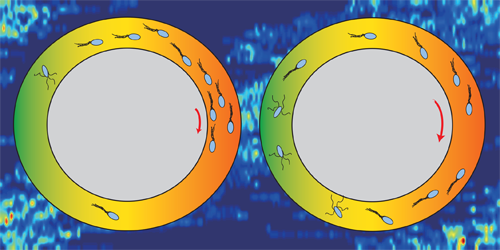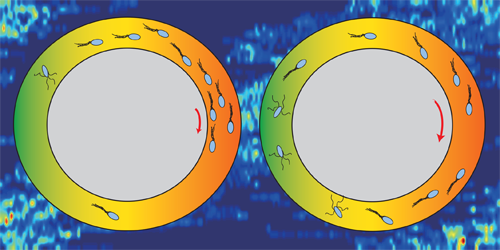Racing Bacteria
Bacteria are constantly monitoring their environment, sensing out the best place to live through chemical cues. But what happens if the most attractive habitat nook keeps moving? New experiments tackle this question by placing E. coli bacteria in a circular micro-racetrack whose floor is a moving chemical wave of attractive peaks and unattractive troughs for the bacteria to follow. The bacteria can track the peaks of slowly moving waves, surfing along the crest. But, when the wave’s speed ramps up, the bacteria no longer keep up and hop backwards from crest-to-crest as the wave flows by.
In collaboration with Yuhai Tu at IBM’s Thomas J. Watson Research Center in New York, Chunxiong Luo and his team at Peking University in China developed a microfluidic device with a ring-shaped channel—the racetrack—around which the bacteria traveled. Different chemicals were pumped into the racetrack through four entryways to create a traveling chemical wave whose peaks and troughs attracted and repelled the bacteria, respectively.
The bacteria had no trouble tracking a single peak for waves traveling at speeds below —the cells clustered on the crests moving at the same pace as the wave. At higher speeds the cells struggled to keep up, something the researchers attribute to the finite sensing time of the bacteria; the bacteria can’t detect their surroundings before the crest moves on. At speeds greater than the bacteria start tracking crests again but this time by hopping backwards from one peak to the next. The team likens this to the thermally driven hopping of particles between troughs of a double-well potential. The microfluidic system developed by the group could be used to study other varying environments, allowing researchers to study the motion of bacteria in realistic settings.
This research is published in Physical Review Letters.
–Katherine Wright
Katherine Wright is a Contributing Editor for Physics.





